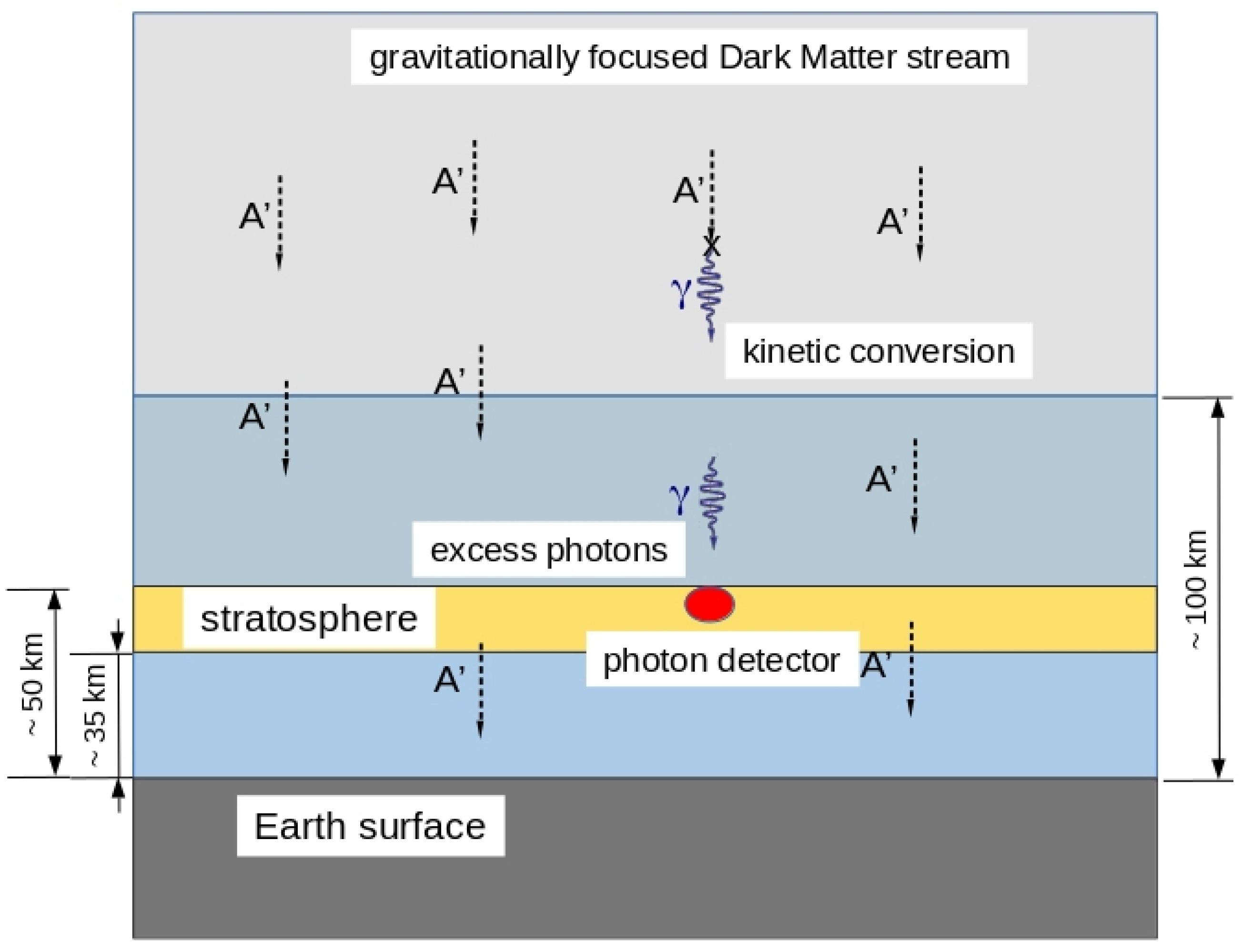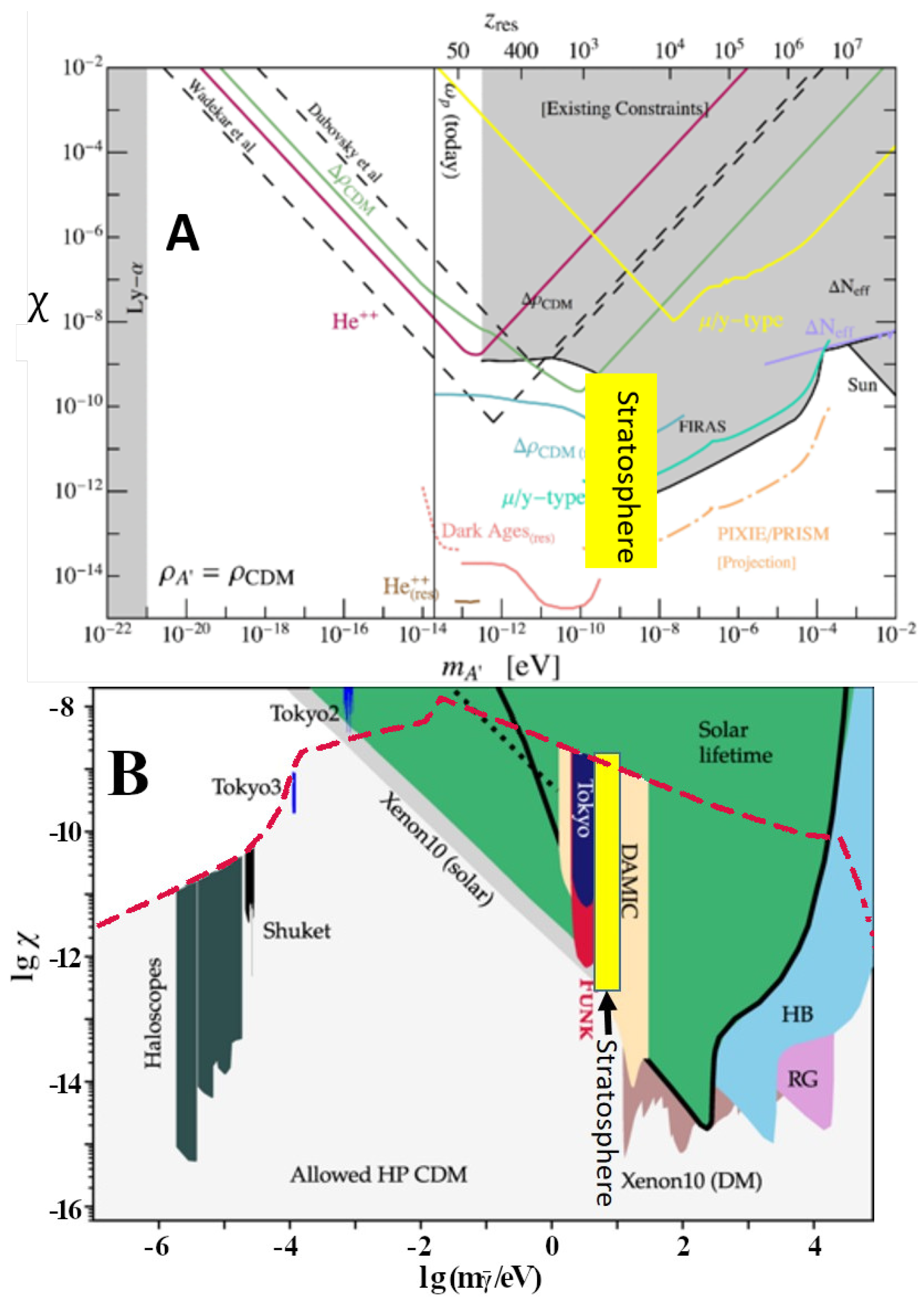Dark Matter Detection in the Stratosphere
Abstract
:1. Introduction
2. The Concept
3. Numerical Calculations
3.1. neV Range
3.2. eV Range
3.2.1. Daytime Measurements
3.2.2. Night-Time Measurements
4. Possible Detectors
5. Conclusions
Author Contributions
Funding
Data Availability Statement
Acknowledgments
Conflicts of Interest
References
- Abercrombie, D.; Akchurin, N.; Akilli, E.; Maestre, J.A.; Allen, B.; Gonzalez, B.A.; Andrea, J.; Arbey, A.; Azuelos, G.; Azzi, P.; et al. Dark Matter benchmark models for early LHC Run-2 Searches: Report of the ATLAS/CMS Dark Matter Forum. Phys. Dark Universe 2020, 27, 100371. [Google Scholar] [CrossRef]
- Zioutas, K.; Argiriou, A.; Fischer, H.; Hofmann, S.; Maroudas, M.; Pappa, A.; Semertzidis, Y.K. Stratospheric Temperature Anomalies as Imprints from the Dark Universe. Phys. Dark Univ. 2020, 28, 100497. [Google Scholar] [CrossRef]
- Sirks, E.L.; Clark, P.; Massey, R.J.; Benton, S.J.; Brown, A.M.; Damaren, C.J.; Eifler, T.; Fraisse, A.A.; Frenk, C.; Funk, M.; et al. Download by Parachute: Retrieval of Assets from High Altitude Balloons. arXiv 2020, arXiv:2004.10764v1. [Google Scholar] [CrossRef]
- Barak, L.; Bloch, I.M.; Cababie, M.; Cancelo, G.; Chaplinsky, L.; Chierchie, F.; Crisler, M.; Drlica-Wagner, A.; Essig, R.; Estrada, J.; et al. SENSEI: Direct-Detection Results on sub-GeV Dark Matter from a New Skipper-CCD. arXiv 2020, arXiv:2004.11378v3. [Google Scholar] [CrossRef] [PubMed]
- Zioutas, K.; Cantatore, G.; Karuza, M.; Kryemadhi, A.; Maroudas, M.; Semertzidis, Y.K. Response-suggestion to The XENON1T excess: An overlooked dark matter signature? arXiv 2020, arXiv:2006.16907. [Google Scholar]
- Emken, T.; Essig, R.; Kouvaris, C.; Sholapurkar, M. Direct Detection of Strongly Interacting Sub-GeV Dark Matter via Electron Recoils. arXiv 2019, arXiv:1905.06348. [Google Scholar] [CrossRef] [Green Version]
- Meier, R.R.; Anderson, G.P.; Cantrell, C.A.; Hall, A.; Lean, J.; Minschwaner, K.; Shetter, R.E.; Shettle, E.P.; Stamnes, K. Actinic radiation in the terrestrial atmosphere. J. Atmos.-Sol.-Terrestial Phys. 1997, 59, 2111. [Google Scholar] [CrossRef]
- Henry, R.C.; Murthy, J.; Overduin, J.; Tyler, J. The mystery of the cosmic diffuse ultraviolet background radiation. Astrophys. J. 2015, 798, 25. [Google Scholar] [CrossRef] [Green Version]
- Cvetič, M.; Langacker, P. Implications of Abelian extended gauge structures from string models. Phys. Rev. D 1996, 54, 3570–3579. [Google Scholar] [CrossRef] [Green Version]
- McDermott, S.D.; Witte, S.J. Cosmological evolution of light dark photon dark matter. Phys. Rev. D 2020, 101, 063030. [Google Scholar] [CrossRef] [Green Version]
- Zioutas, K.; Tsagri, M.; Semertzidis, Y.; Papaevangelou, T.; Dafni, T.; Anastassopoulos, V. Axion searches with helioscopes and astrophysical signatures for axion(-like) particles. New J. Phys. 2009, 11, 105020. [Google Scholar] [CrossRef] [Green Version]
- Anastassopoulos, V.; Aune, S.; Barth, K.; Belov, A.; Cantatore, G.; Carmona, J.M.; Castel, J.F.; Cetin, S.A.; Christensen, F.; Collar, J.I.; et al. New CAST limit on the axion–photon interaction. Nat. Phys. 2017, 13, 584–590. [Google Scholar]
- Adair, C.; Altenmüller, K.; Anastassopoulos, V.; Cuendis, S.A.; Baier, J. Search for Dark Matter Axions with CAST-CAPP. Nat. Commun. 2022, 13, 6180. [Google Scholar] [CrossRef] [PubMed]
- Bertolucci, S.; Zioutas, K.; Hofmann, S.; Maroudas, M. The Sun and its Planets as detectors for invisible matter. Phys. Dark Univ. 2017, 17, 13–21. [Google Scholar] [CrossRef]
- Arvanitaki, A.; Dimopoulos, S.; Tilburg, K.V. Resonant absorption of bosonic dark matter in molecules. arXiv 2017, arXiv:1709.05354. [Google Scholar] [CrossRef] [Green Version]
- Gelmini, G.B.; Millar, A.J.; Takhistov, V.; Vitagliano, E. Probing Dark Photons with Plasma Haloscopes. arXiv 2020, arXiv:2006.06836v2. [Google Scholar] [CrossRef]
- Dubovsky, S.; Chiffle, G.H. Heating up the Galaxy with Hidden Photons. arXiv 2018, arXiv:1509.00039. [Google Scholar] [CrossRef]
- An, H.; Ge, S.; Liu, J. Solar Radio Emissions and Ultralight Dark Matter. Universe 2023, 9, 142. [Google Scholar] [CrossRef]
- Mirizzi, A.; Redondo, J.; Sigl, G. Microwave background constraints on mixing of photons with hidden photons. J. Cosmol. Astropart. Phys. 2009, 2009, 026. [Google Scholar] [CrossRef]
- Caputo, A.; Witte, S.; Blas, D.; Pani, P. Electromagnetic Signatures of Dark Photon Superradiance. arXiv 2021, arXiv:2102.11280v2. [Google Scholar] [CrossRef]
- Stankov, S.M.; Jakowski, N.; Heise, S.; Muhtarov, P.; Kutiev, I.; Warnant, R. A new method for reconstruction of the vertical electron density distribution in the upper ionosphere and plasmasphere. J. Geophys. Res. Space Phys. 2003, 108, 1164. [Google Scholar] [CrossRef]
- García, A.; Bondarenkob, K.; Ploeckingerd, S.; Pradlere, J.; Sokolenko, A. Effective photon mass and (dark) photon conversion in the inhomogeneous Universe. J. Cosmol. Astropart. Phys. 2020, 2020, 11. [Google Scholar] [CrossRef]
- An, H.; Chen, X.; Ge, S.; Liu, J.; Luo, Y. Searching for Ultralight Dark Matter Conversion in Solar Corona using LOFAR Data. arXiv 2023, arXiv:2301.03622v1. [Google Scholar]
- Sofue, Y. Gravitational Focusing of Low-Velocity Dark Matter on the Earth’s Surface. Galaxies 2020, 8, 42. [Google Scholar] [CrossRef]
- Kryemadhi, A.; Maroudas, M.; Mastronikolis, A.; Zioutas, K. Gravitational focusing effects on streaming dark matter as a new detection concept. arXiv 2022, arXiv:2210.07367v2. [Google Scholar]
- Horns, D.; Jaeckel, J.; Lindner, A.; Lobanov, A.; Redondo, J.; Ringwald, A. Searching for WISPy Cold Dark Matter with a Dish Antenna. arXiv 2012, arXiv:1212.2970. [Google Scholar] [CrossRef]
- Carr, J.J. Practical Antenna Handbook, 5th ed.; McGraw-Hill Education: New York, NY, USA, 2012. [Google Scholar]
- Arza, A.; Kryemadhi, A.; Zioutas, K. Searching for Axion Streams with the Echo Method. 2023. Available online: http://xxx.lanl.gov/abs/2212.10905v3 (accessed on 23 May 2023).
- Chaudhuri, S.; Irwin, K.; Graham, P.W.; Mardon, J. Fundamental Limits of Electromagnetic Axion and Hidden-Photon Dark Matter Searches: Part I-The Quantum Limit. arXiv 2018, arXiv:1803.01627. [Google Scholar]
- Lacki, B. The end of the rainbow: What can we say about the extragalactic sub-megahertz radio sky? Mon. Not. R. Astron. Soc. 2010, 406, 863. [Google Scholar] [CrossRef] [Green Version]
- Andrianavalomahefa, A.; Schäfer, C.M.; Veberič, D.; Engel, R.; Schwetz, T.; Mathes, H.J.; Daumiller, K.; Roth, M.; Schmidt, D.; Ulrich, R.; et al. Limits from the FUNK experiment on the mixing strength of hidden-photon dark matter in the visible and near-ultraviolet wavelength range. Phys. Rev. D 2020, 102, 042001. [Google Scholar] [CrossRef]
- Knoll, G.F. Radiation Detection and Measurements, 4th ed.; Wiley: Hoboken, NJ, USA, 2010. [Google Scholar]
- Gorham, P.; Anderson, J.; Bernasconi, P.; Chakrabarti, S.; Guzik, T.G.; Jones, W.; Kierans, C.; Millan, R.; Vieregg, A.; Walker, C.; et al. A Roadmap For Scientific Ballooning 2020–2030. arXiv 2022, arXiv:2210.01198. [Google Scholar]
- Henning, P.; Ellingson, S.W.; Taylor, G.B.; Craig, J.; Pihlström, Y.; Rickard, L.J.; Clarke, T.E.; Kassim, N.E.; Cohen, A. The first station of Long Wavelength Array. arXiv 2010, arXiv:1009.0666. [Google Scholar]
- Bonesini, M.; Cervi, T.; Menegolli, A.; Prata, M.; Raselli, G.; Rossella, M.; Spanu, M.; Torti, M. Detection of Vacuum Ultraviolet light by means of SiPM for High Energy Physics experiments. Nucl. Instruments Methods Phys. Res. Sect. Accel. Spectrometers Detect. Assoc. Equip. 2018, 912, 235–237. [Google Scholar] [CrossRef]
- Karuza, M.; Cantatore, G.; Gardikiotis, A.; Hoffmann, D.H.H.; Semertzidis, Y.K.; Zioutas, K. KWISP: An ultra-sensitive force sensor for the Dark Energy sector. Phys. Dark Univ. 2016, 12, 100–104. [Google Scholar] [CrossRef] [Green Version]
- Cuendis, S.A.; Baier, J.; Barth, K.; Baum, S.; Bayirli, A.; Belov, A.; Bräuninger, H.; Cantatore, G.; Carmona, J.M.; Castel, J.F.; et al. First results on the search for chameleons with the KWISP detector at CAST. Phys. Dark Univ. 2019, 26, 100367. [Google Scholar]
- Gori, P.M.; Vakili, F.; Rivet, J.P.; Guerin, W.; Hugbart, M.; Chiavassa, A.; Vakili, A.; Kaiser, R.; Labeyrie, G. I3T: Intensity Interferometry Imaging Telescope. Mon. Not. R. Astron. Soc. 2021, 505, 2328–2335. [Google Scholar] [CrossRef]



Disclaimer/Publisher’s Note: The statements, opinions and data contained in all publications are solely those of the individual author(s) and contributor(s) and not of MDPI and/or the editor(s). MDPI and/or the editor(s) disclaim responsibility for any injury to people or property resulting from any ideas, methods, instructions or products referred to in the content. |
© 2023 by the authors. Licensee MDPI, Basel, Switzerland. This article is an open access article distributed under the terms and conditions of the Creative Commons Attribution (CC BY) license (https://creativecommons.org/licenses/by/4.0/).
Share and Cite
Cantatore, G.; Çetin, S.A.; Fischer, H.; Funk, W.; Karuza, M.; Kryemadhi, A.; Maroudas, M.; Özbozduman, K.; Semertzidis, Y.K.; Zioutas, K. Dark Matter Detection in the Stratosphere. Symmetry 2023, 15, 1167. https://doi.org/10.3390/sym15061167
Cantatore G, Çetin SA, Fischer H, Funk W, Karuza M, Kryemadhi A, Maroudas M, Özbozduman K, Semertzidis YK, Zioutas K. Dark Matter Detection in the Stratosphere. Symmetry. 2023; 15(6):1167. https://doi.org/10.3390/sym15061167
Chicago/Turabian StyleCantatore, Giovanni, Serkant A. Çetin, Horst Fischer, Wolfgang Funk, Marin Karuza, Abaz Kryemadhi, Marios Maroudas, Kaan Özbozduman, Yannis K. Semertzidis, and Konstantin Zioutas. 2023. "Dark Matter Detection in the Stratosphere" Symmetry 15, no. 6: 1167. https://doi.org/10.3390/sym15061167
APA StyleCantatore, G., Çetin, S. A., Fischer, H., Funk, W., Karuza, M., Kryemadhi, A., Maroudas, M., Özbozduman, K., Semertzidis, Y. K., & Zioutas, K. (2023). Dark Matter Detection in the Stratosphere. Symmetry, 15(6), 1167. https://doi.org/10.3390/sym15061167






